WASHINGTON (Reuters) - U.S. construction spending unexpectedly fell in May as higher mortgage rates depressed single-family homebuilding, and recovery is likely to be muted by improving housing supply.
The Commerce Department's Census Bureau said on Monday that construction spending dipped 0.1% after an upwardly revised 0.3% increase in April. Economists polled by Reuters had forecast construction spending rebounding 0.2% after a previously reported 0.1% fall in April.
Construction spending increased 6.4% year-on-year in May.
Spending on private construction projects slipped 0.3% in May after rising 0.4% in the prior month. Investment in residential construction dropped 0.2% after surging 0.9% in April. Outlays on new single-family construction projects decreased 0.7%. Spending on multi-family housing was unchanged.
Mortgage rates shot up in May, hurting homebuilder confidence, homebuilding and home sales.
Housing supply has improved considerably as the higher borrowing costs stifle demand, which could limit growth in new construction. The inventory of previously owned homes in May was the largest since August 2022, while new housing supply was the highest in more than 16 years.

Residential investment is expected to have slowed sharply in the second quarter after logging double-digit growth in the January-March quarter.
In May, spending on private non-residential structures like factories fell 0.3%. Investment in public construction projects increased 0.5% after being unchanged in April. State and local government spending gained 0.2% and outlays on federal government projects surged 3.1%.